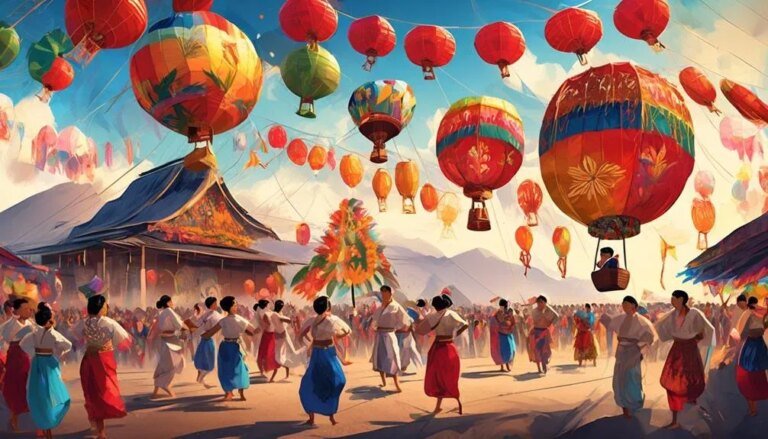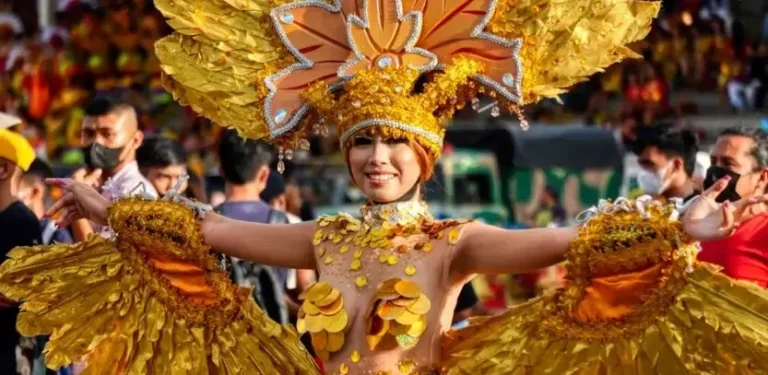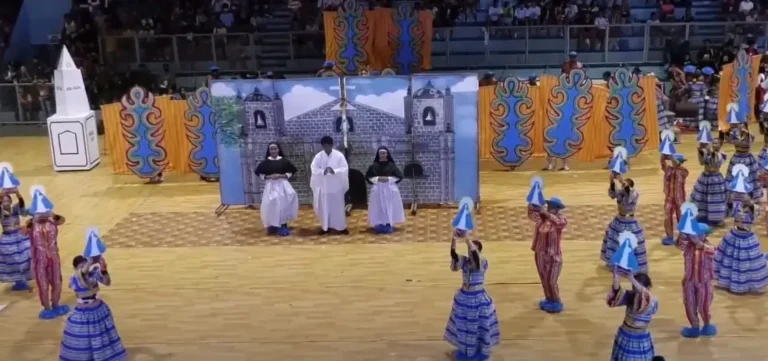Tawo-Tawo Festival Bayawan City, Negros Oriental Philippines
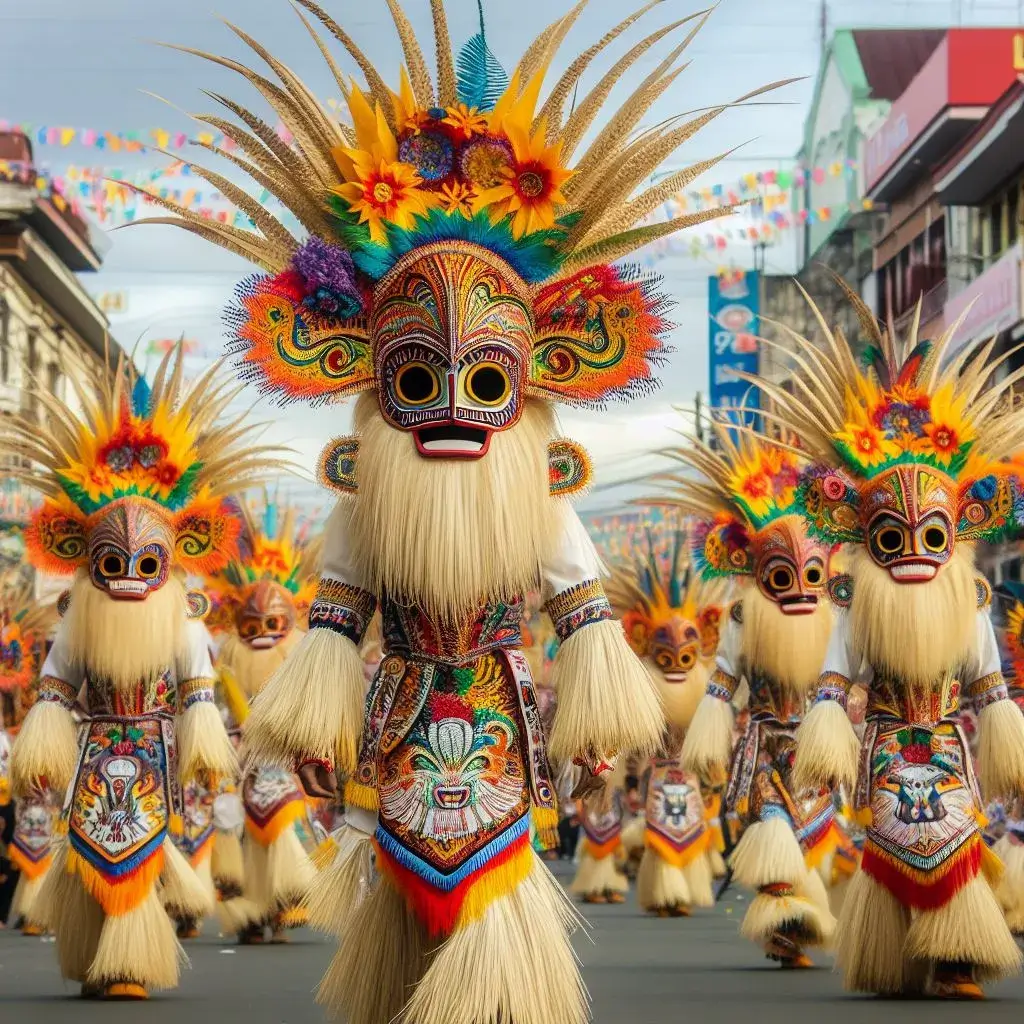
Like a bird soaring high above the clouds, you’re free to explore the vibrant culture of the Philippines through the Tawo-Tawo Festival in Bayawan City, Negros Oriental.
You’ll witness a grand celebration of agricultural abundance, symbolized by vibrant street dancing and festive costumes. The festival’s highlight is the creation of life-sized scarecrows, signifying the city’s rich farming traditions.
As you delve deeper into the event, you’ll understand the locals’ deep-rooted connection with the land.
The Tawo-Tawo Festival isn’t just a feast for the eyes, it’s a celebration of life, freedom, and the enduring spirit of the Filipino people.
Key Takeaways
- The Tawo-Tawo Festival originated from Bayawan City’s agricultural past and is a celebration of the city’s rich history and cultural heritage.
- The festival symbolizes the city’s resilience and desire for freedom, with scarecrows representing the community’s strength.
- Street dancing is the highlight of the festival, showcasing the artistic mastery and cultural richness of the region.
- The festival includes harvest rituals, farming traditions, and costume play, providing an authentic glimpse into agricultural life and local culture.
Klook.comWhat Is Tawo-Tawo Festival Philippines?
The Tawo-Tawo Festival is a yearly event held in Bayawan City, Negros Oriental, Philippines. It is a celebration of the city’s bountiful harvest and the locals’ thanksgiving to their patron saint, Saint Theresita. The festival is named after the tawo-tawo, a local term for scarecrows, which are believed to protect the crops from birds. During the festival, participants dress up in colorful costumes and dance to the beat of the drums while carrying tawo-tawo replicas. The festival also features street dancing, beauty pageants, and other cultural activities.
Facts About Tawo-Tawo Festival Philippines
| Facts | Explanation |
|---|---|
| Name of the festival: | Tawo-Tawo Festival |
| Type of festival: | Cultural and religious festival |
| City of Origin | Bayawan City, Negros Oriental |
| Festival Etymology | “Tawo-Tawo” comes from the local term for scarecrows, which are used by farmers to scare away birds from their fields. |
| Date When It Was Celebrated First | August 17, 2001 |
| Founder of the Festival | The Local Government of Bayawan City |
| Brief history of the festival: | The Tawo-Tawo Festival is a celebration that honors the agricultural lifestyle of the people of Bayawan City, highlighting the importance of scarecrows in protecting their crops. It began as a way to celebrate the city’s charter day and has evolved into a colorful and vibrant event that showcases the creativity and hard work of its people. |
| Brief history of the city: | Bayawan City, situated in the southwestern part of Negros Oriental, has a rich history that dates back to the pre-Spanish era. Initially known as Tolong Nuevo, it became a city in December 2000. Bayawan City is known for its agricultural lands, being a major producer of rice, corn, and coconut in the region. |
| Ethnic Information of the City and Region | The population of Bayawan City primarily consists of Visayan-speaking people, mainly Cebuanos, with a mix of other ethnic groups such as the Hiligaynon and Ilocanos. Negros Oriental, the region where Bayawan City is located, is predominantly inhabited by Visayan ethnic groups. |
| Location of the city in the country: | Bayawan City is located on the southern tip of Negros Oriental, Visayas region, in the Philippines. It faces the Sulu Sea to the west. |
| How to reach the city: | – By air: The nearest major airport to Bayawan City is Dumaguete Airport, which serves domestic flights from Manila and Cebu. From the airport, visitors can take a taxi or a bus to reach Bayawan City, approximately 97 kilometers away. – By sea: Bayawan City is accessible by ferry from Cebu City. Several shipping lines operate regular trips between these two cities. |
| Nearby cities or towns and their distance from the city: | – Dumaguete City (105 km to the north) – Sipalay City (roughly 80 km to the southwest, in Negros Occidental) – Bais City (about 70 km to the north) |
| Google map link to the city location: | Bayawan City on Google Maps |
| Ethnic information (if available): | Bayawan City is home to various ethnic groups, including the Visayan people, who are the predominant population in the region. The Visayans have a rich cultural heritage and are known for their traditional music, dances, and crafts. |
| Festival main events and activities: | – Street Dancing Competition – Float Parade showcasing colorful and creative displays – Trade Fair featuring local products and delicacies – Cultural Performances highlighting traditional dances and music – Beauty Pageant showcasing local talent – Thérèsean Dance Contest – Agricultural exhibits showcasing the city’s agricultural produce – Fireworks Display illuminating the sky at night |
| Other famous tourist attractions in the city: | – Bayawan Boulevard (a scenic coastal road ideal for strolls and watching sunsets) – Niludhan Falls (a magnificent waterfall perfect for nature lovers) – Tabon Caves (historical site with archaeological importance) |
| Landmarks in the city: | – St. Thérèse of the Child Jesus Parish Church: A beautiful Catholic church dedicated to the patron saint of Bayawan City. – Poblacion Park: A central park where locals and tourists can relax, enjoy recreational activities, and witness various events. – Rizal Park: A park honoring Philippine national hero Dr. Jose Rizal, providing a serene environment for leisurely walks. – Bayawan City Hall: The seat of government where administrative functions are carried out. – Sandugan Beach: A scenic beach popular among locals for swimming and picnicking. |
| Related festivals in the same region: | – Buglasan Festival (Dumaguete City): A week-long celebration featuring cultural shows, street dancing competitions, food fairs, and beauty pageants to showcase the culture and heritage of Negros Oriental. – Kulasihan Festival (Bais City): A unique festival celebrating Bais City’s rich history and culture through street dancing, parade floats, cultural presentations, and various competitions. – Pamukad Festival (Tanjay City): A thanksgiving festival highlighting Tanjay City’s agricultural heritage through street dancing, exhibits, and trade fairs. |
History Of Tawo-Tawo Festival Philippines
The Tawo-Tawo Festival is a cultural and agricultural festival held annually in the city of Bayawan, located in the Negros Oriental province of the Philippines. The festival is named after the scarecrows, locally known as “tawo-tawo,” which are commonly used by farmers in the region to scare away birds and pests from their rice fields. The festival is a celebration of the city’s agricultural heritage, showcasing the importance of agriculture and the ingenuity of local farmers.
The Tawo-Tawo Festival typically takes place in February, aligning with the city’s charter day celebrations. It features a variety of events, including street dancing competitions, agricultural shows, and cultural exhibitions. Participants in street dancing events often dress in colourful costumes inspired by scarecrows and perform dances that mimic the movements of these figures, accompanied by lively music.
Understanding the Tawo-Tawo Festival
During your visit to the Tawo-Tawo Festival, you’ll quickly grasp that it’s not just a celebration, but a vibrant display of Bayawan City’s rich history and cultural heritage.
This festival’s origins trace back to the city’s agricultural past, where scarecrows, or ‘Tawo-Tawo’, were used to ward off birds from the rice fields. This annual event is a salute to those humble beginnings, a symbol of the city’s resilience and desire for freedom.
The cultural implications run deep. It’s not only about preserving history but also about instilling pride in the younger generation. You’ll witness locals and tourists alike, dancing, wearing scarecrow-inspired costumes, telling the world, ‘We’re free, we’re strong, and we’re proud of our heritage.’
The Agricultural Significance of the Celebration
Heart of this celebration, you’ll find a deep-rooted connection to Bayawan City’s agricultural background, which is far more than just a historical footnote.
Crop symbolism pervades the Tawo-Tawo festival, mirroring the city’s gratitude for its rich farmlands. Scarecrow-like figures, designed to protect the crops, are paraded with pride, symbolizing the community’s resilience and strength.
Festival foods are also a vital component, each dish reflecting the bountiful yield of the region. You’ll taste the freedom in every bite, as the majority of ingredients are locally sourced, embodying the city’s commitment to sustainable farming.
This celebration isn’t just an entertaining spectacle, it’s a tribute to Bayawan’s agricultural heritage, a testament to the city’s independent spirit, and a call to honour Mother Earth.
Street Dancing: Highlight of the Festival
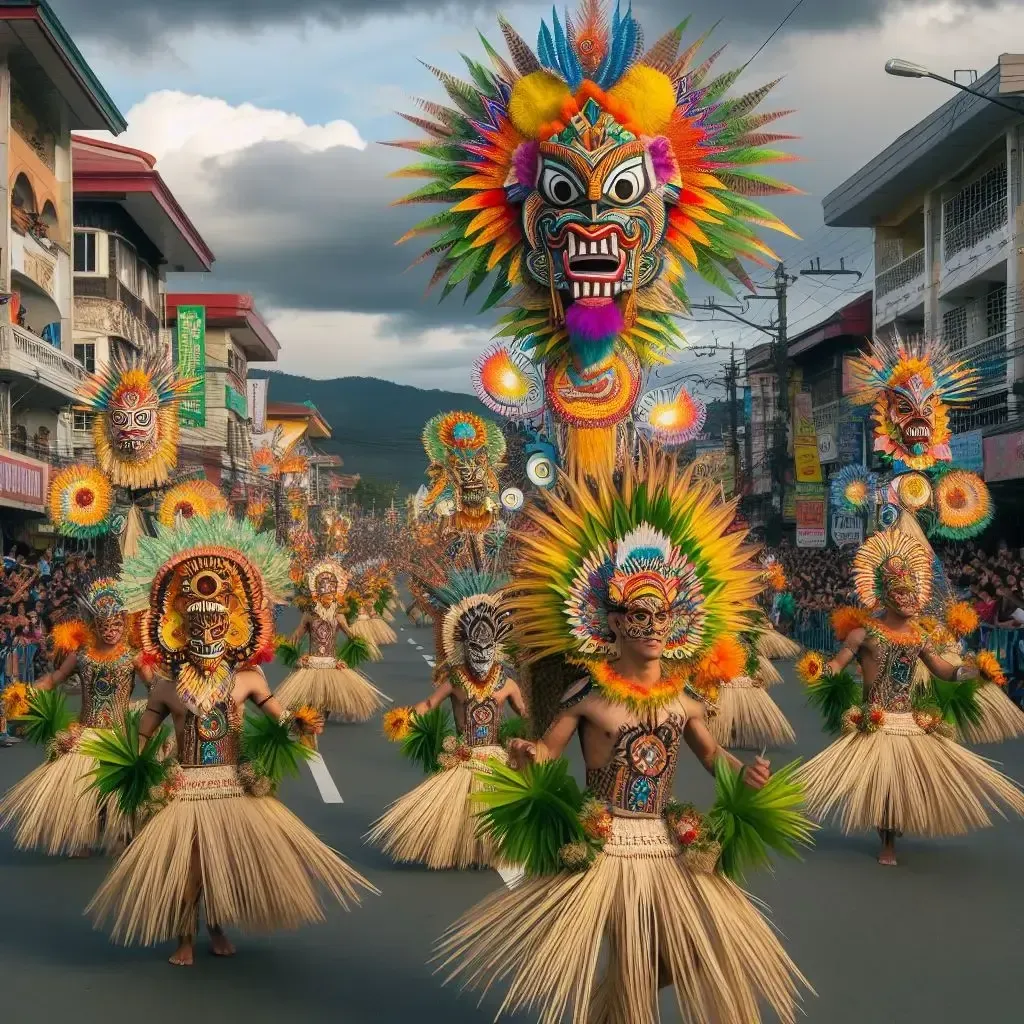
You’ll find every moment of the Tawo-Tawo Festival’s magnificent street dancing, a spectacle that’s not to be missed. It’s the highlight of the festival, where the vibrant cultural expressions of Negros Oriental come alive. The dance choreography is a sight to behold, wonderfully arranged to showcase the local traditions and folklore.
To paint a picture for you:
Dressed in colorful traditional outfits, they represent the freedom-loving spirit of Bayawan City.
Intricate steps and movements, showcasing the artistic mastery and cultural richness of the region.
The rhythmic beats, the cheering crowds, the festive ambience that captivates your senses.
Witnessing this spectacle, you’ll appreciate the depth of cultural heritage and the spirit of community that the Tawo-Tawo Festival represents.
Harvest Festival and Farming Rituals
Moving on from the mesmerizing street dancing, the harvest festival and farming rituals become the heart of Tawo-Tawo Festival’s cultural fabric, offering you an authentic glimpse into the agricultural life of Bayawan City.
It’s more than just a show; it’s a ritual with deep significance and cultural impact.
To give you a better understanding, here’s a breakdown:
| Activities | Ritual Significance | Cultural Impact |
|---|---|---|
| Rice Planting Ritual | Invoking blessings for a bountiful harvest | Cultivates the community’s unity and cooperation |
| Tawo-Tawo Making | Symbolizes the farmers’ scarecrows | Preserves traditional craftsmanship |
| Harvest Parade | Celebration of agricultural abundance | Promotes local tourism and economic growth |
| Farmers Games | Recreation of traditional farming activities | Keeps the younger generation connected to their roots |
| Feast of Locally Grown Food | Appreciation of the harvest | Encourages sustainable and organic farming |
In participating, you’re not just a spectator, but a part of a living tradition that values freedom, community, and the fruits of hard work.
Costume Play During Tawo-Tawo Festival
Dive into the vibrant world of costume play during the Tawo-Tawo Festival, where you’ll be captivated by the creative expressions of local culture and tradition.
Here, the importance of role-playing is fully realized, embodying the spirit and stories of the community.
- Costume Designing Techniques:
- Intricate patterns and vibrant colours are used to create visually striking costumes.
- Materials like beads, feathers, and shells are often incorporated, reflecting the natural environment.
- Headdresses and masks are common, adding an extra layer of dramatic flair.
These costumes aren’t just for show – they’re an integral part of the festival, allowing you to fully immerse yourself in the local culture.
Surprising Facts About The Tawo-Tawo Festival Philippines
- 🌾 The Tawo-Tawo Festival is not just a celebration but a ritual for good harvests, deeply rooted in the agricultural traditions of Bayawan City.
- 🎭 Participants in the festival’s street dances wear costumes made from indigenous materials, reflecting the creativity and resourcefulness of the local community.
- 🌱 Aside from scarecrows, the festival also honours the rice deity, a testament to the community’s respect for nature and its bounties.
- 🤝 The festival fosters community spirit by involving schools, local government units, and various organizations in its activities, promoting unity and cooperation.
- 🎨 The Tawo-Tawo Festival includes a competition for the best scarecrow design, showcasing artistic talents and innovative interpretations of traditional scarecrows.
- 💃 The dance routines performed during the festival tell stories of agricultural life, struggles, and successes, serving as a living museum of local folklore and traditions.
- 🍚 One unique aspect of the Tawo-Tawo Festival is its focus on sustainable agriculture, with events dedicated to organic farming techniques and environmental conservation.
- 🎉 The festival’s climax features a grand parade of floats decorated with agricultural products, highlighting the richness and diversity of Bayawan’s harvests.
- 🏆 Despite its local roots, the Tawo-Tawo Festival has gained recognition beyond Bayawan City, attracting tourists and cultural enthusiasts from across the Philippines and beyond.
- 🌳 The Tawo-Tawo Festival also includes tree planting activities, emphasizing the community’s commitment to environmental stewardship and sustainable development.
Famous Food Dishes of Bayawan City in Negros Oriental
Bayawan City is known for its rich agricultural lands and diverse culinary offerings that reflect its cultural heritage and agricultural base. Here are some of the famous food dishes from Bayawan City:
- Binignit – A Visayan dessert soup made from glutinous rice, sweet potatoes, taro, bananas, sugar, and coconut milk. It’s especially popular during Holy Week but enjoyed year-round.
- Budbud Kabog – A type of suman (rice cake) made from millet instead of the usual glutinous rice, sweetened and wrapped in banana leaves. Kabog is the local term for millet, which is a staple grain in the area.
- Chicken Inasal – Though widely known across the Philippines, Chicken Inasal in Bayawan has its unique local twist, marinated in a mixture of calamansi, pepper, coconut vinegar, and annatto, then grilled over hot coals.
- Lechon Baboy – Roasted pig is a festive dish in the Philippines, and Bayawan City’s version is known for its crispy skin and flavorful meat, often served with a liver-based sauce.
- Kinilaw – A raw seafood dish similar to ceviche, made with fresh fish, vinegar, calamansi juice, ginger, and chilies. It reflects the city’s access to fresh seafood.
- Sinuglaw – A combination of grilled pork (sinugba) and kinilaw, this dish is a testament to the fusion of flavors that Bayawan’s culinary scene offers.
- Laoya – A traditional Negrense stew made of pork legs simmered in a broth with spices, bananas, and vegetables. It’s a comfort food that showcases local ingredients.
- Balbacua – A slow-cooked stew made from beef, ox feet, or skin, thickened with peanuts or peanut butter, and seasoned with spices. It’s a dish with deep flavours, reflecting the Spanish influence on Filipino cuisine.
- Puto Maya and Sikwate – A popular breakfast or snack combo in Bayawan, consisting of sticky rice (puto maya) served with hot chocolate (sikwate) made from local cacao.
- Seafood Dishes – Given its coastal location, Bayawan City offers a variety of seafood dishes, including grilled fish, squid, and shrimp, often seasoned with local herbs and spices.
Famous Historical Landmarks In Bayawan City in Negros Oriental
Bayawan City may not have as many widely recognized historical landmarks as some other places in the Philippines, but Bayawan City does feature sites of historical and cultural interest. Here are some notable landmarks in and around Bayawan City:
- St. Nicholas of Tolentino Parish Church: This church is a significant landmark in Bayawan City, serving as a spiritual centre for the local Catholic community. It showcases the religious heritage and architectural style that has been preserved over the years.
- Bayawan Boulevard: While not a historical landmark in the traditional sense, Bayawan Boulevard is significant for its role in the city’s social and cultural activities. It’s a popular gathering place for locals and visitors, offering scenic views of the coast and serving as a venue for various events and festivals.
- Cabcabon Banog Falls: Located near Bayawan City, this natural attraction is part of the area’s ecological and historical landscape. The falls and surrounding areas are not only beautiful but also hold significance for the local communities that have lived in and around these natural resources for generations.
- Niludhan Falls: Another breathtaking natural landmark, Niludhan Falls is known for its majestic beauty and is a popular destination for tourists and locals alike. While it is more of a natural landmark than a historical one, places like Niludhan Falls contribute to the historical narrative of the region by showcasing its natural heritage.
- Tabuan Market: This local market is a vital part of Bayawan’s community life, offering insights into the local economy, agricultural practices, and culinary traditions. Markets like Tabuan have been central to community life for generations, serving as hubs of trade and socialization.
- Tawo-Tawo Festival Grounds: While not a landmark in the traditional sense, the venues used for the Tawo-Tawo Festival hold cultural significance. The festival itself is a reflection of Bayawan’s agricultural heritage and community spirit, making the places associated with it landmarks of cultural importance.
Bayawan City’s landmarks are more reflective of its natural beauty, agricultural heritage, and community life rather than the conventional historical sites found in older cities in the Philippines.
How To Reach Bayawan City in Negros Oriental
Reaching Bayawan City in Negros Oriental, Philippines, involves several transportation options, depending on your starting location. Bayawan City is located on the southwestern coast of Negros Island. Here’s how you can get there:
From Manila (Capital of the Philippines)
- By Air and Land: The most common route involves flying from Ninoy Aquino International Airport (NAIA) in Manila to Dumaguete City, the capital of Negros Oriental. The flight usually takes about 1 hour and 15 minutes. From Dumaguete, you can take a bus or a van heading to Bayawan City. The land travel from Dumaguete to Bayawan takes approximately 3 to 4 hours, depending on the mode of transportation and traffic conditions.
From Cebu City
- By Fast Craft and Land: Another option is travelling from Cebu City to Dumaguete City by fast craft, which takes about 3 to 4 hours. From the port of Dumaguete, you can then take a bus or van to Bayawan City.
- Direct Bus: There are also direct buses from Cebu City to Bayawan City. These buses go aboard a ferry to cross the water separating the islands of Cebu and Negros. The total travel time can vary but expect it to take around 6 to 7 hours.
Within Negros Island
- By Bus: If you’re already on Negros Island, the most straightforward way to reach Bayawan City is by bus. The Ceres Liner bus company operates regular trips that cover different routes across the island, including routes from major cities and towns to Bayawan.
- By Private Vehicle: Traveling by private vehicle allows for a more flexible schedule. The route from Dumaguete to Bayawan via the national highway is scenic and well-paved. It’s a straightforward drive southwest along the coast, passing through several towns.
Tips for Travelers
- Check the Schedule: It’s always a good idea to check the latest travel schedules for buses, vans, and ferries as they can change due to weather conditions or public holidays.
- Travel Light: If you’re taking public transportation, travelling light will make your journey easier, especially since transfers are involved.
- Local Transportation: Once in Bayawan City, there are tricycles and motorcycles (habal-habal) that can take you to specific destinations within the city.
Location Of Bayawan City In The Philippines
Frequently Asked Questions
What Are the Best Accommodations and Eateries Near the Tawo-Tawo Festival?
You’ll find top-notch accommodations like the GV Hotel. For dining, try Jollibee or Chowking. Don’t forget to explore local crafts and festival fashion in nearby boutiques to truly immerse yourself in the local culture.
What Other Tourist Attractions Are There in Bayawan City, Negros Oriental Aside From the Tawo-Tawo Festival?
You’ll love exploring Bayawan’s Wildlife Diversity, a treasure trove of unique species. Also, don’t miss the traditional crafts shopping for authentic souvenirs. There’s more to Bayawan than just the festival, it’s a whole adventure on its own.
How Can I Get to Bayawan City, Negros Oriental From Manila?
You can fly from Manila to Dumaguete, then take a bus to Bayawan City. Remember your travel essentials and enjoy the journey! Manila Bayawan transportation is quite a breeze if you’re up for an adventure.
Are There Any Safety Measures in Place During the Tawo-Tawo Festival?
Yes, safety measures are in place during festivals. Authorities ensure crowd control, medical assistance, and secure parade routes. It’s part of preserving the cultural significance and origins of such vibrant events. Enjoy safely!
Are There Any Special Discounts or Packages for Tourists During the Tawo-Tawo Festival?
Yes, during festivals, there are usually special discounts or packages for tourists. You’ll enjoy reduced prices on festival activities, allowing you to fully experience the cultural significance without breaking the bank. It’s well worth checking out!
Conclusion
In conclusion, the Tawo-Tawo Festival in Bayawan City is a vibrant testament to the city’s rich agricultural heritage and community spirit.
It’s a time when the streets come alive with colour and energy as locals pay homage to the humble scarecrow, the protector of their crops. Whether you’re a curious visitor or a proud local, the festival offers a unique glimpse into the cultural heart of the Philippines.
Remember, getting there is part of the adventure, whether you choose to fly, sail, or drive. And once you’re there, cozy accommodations and the warm, welcoming nature of the people are sure to make your stay memorable.
So pack your bags, embrace the spirit of Bayawan, and let the Tawo-Tawo Festival leave you with stories to tell and memories to cherish!

